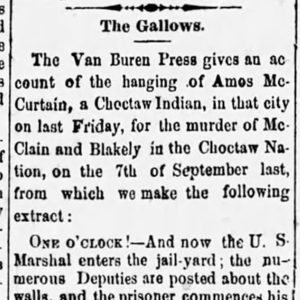calsfoundation@cals.org
Amos McCurtain (Execution of)
Amos McCurtain was a Choctaw man hanged at Van Buren (Crawford County) on June 24, 1870, for a double murder in what would be the first public execution in Crawford County since the end of the Civil War.
Amos McCurtain and William Fry, another Choctaw man, were traveling by wagon between Scullyville and Boggy Depot in the Indian Territory on September 7, 1869, when they encountered a wagon driven by James McClain, who was Choctaw, and James Blakely, a Black man. McCurtain and Fry stopped to camp for the night, and the other two men stopped and camped near them.
As McClain and Blakely slept, McCurtain proposed killing the pair and stealing the goods from their wagon. Fry opposed the plan and went to sleep but woke up that night to find “McCurtain standing over him with a revolver in one hand and in the other an axe clotted with blood and hair.” McCurtain told Fry he had killed the two men with the axe and then ordered him to help move the bodies or suffer a similar fate.
They tied McClain’s body to a pony and dragged it about 200 yards into the brush, then put Blakely’s body into their wagon, along with the cargo from the dead men’s wagon. McCurtain then returned to McClain’s corpse, and “taking from it the pantaloons, put them on, remarking they were too good to be lost.”
After going about a mile, they stopped and dumped Blakely’s body in the brush. They parted ways shortly after. Fry was arrested on the road the next day; he then told the marshals about the murders. Authorities arrested McCurtain at his home in the Choctaw Nation two days later and brought both men to Van Buren, where Fry was released after agreeing to testify against McCurtain.
McCurtain was tried in the U.S. District Court in November, and “the evidence was irresistible and the jury remained in consultation but a few minutes and returned a verdict ‘guilty of murder in the first degree.’” McCurtain was too sick to be sentenced before that term of the court ended, and it would be May 1870 before he learned his fate. Hearing he was to be hanged, “so great was his emotion, so strong his fear, that the guards were well nigh necessitated to carry McCurtain down the stairs and over to the jail.”
The day before his execution, McCurtain told a reporter that Fry had actually killed Blakely. He then met with a preacher and “heartily repented of his misdeeds and hoped for forgiveness.” A cousin of McClain’s also came to the jail and visited the condemned man as the gallows were being constructed outside.
A crowd assembled in Van Buren on June 24 to watch the hanging, but the sheriff instead opted to execute McCurtain in the jail yard. The sheriff and a guard accompanied him as he climbed the stairs to the gallows, and McCurtain declined to make a final statement. When the hood was placed over his head, a newspaper reported “little doubt that McCurtain had fainted,” and two deputies held him up as the noose was placed around his neck.
He likely was unconscious when the trap door was opened, and “his neck was not broken by the fall, and life did not totally cease until eighteen minutes after his swinging off.”
For additional information:
“The Gallows.” Fayetteville Weekly Democrat, July 2, 1870, p. 2.
“State News.” Arkansas Gazette, November 28, 1869, p. 3.
“State News.” Arkansas Gazette, December 15, 1869, p. 3.
“State News.” Arkansas Gazette, June 26, 1870, p. 3.
“State News.” Arkansas Gazette, June 30, 1870, p. 3.
Mark K. Christ
Central Arkansas Library System
 Law
Law Post-Reconstruction through the Gilded Age, 1875 through 1900
Post-Reconstruction through the Gilded Age, 1875 through 1900 McCurtain Execution Story
McCurtain Execution Story 




Comments
No comments on this entry yet.